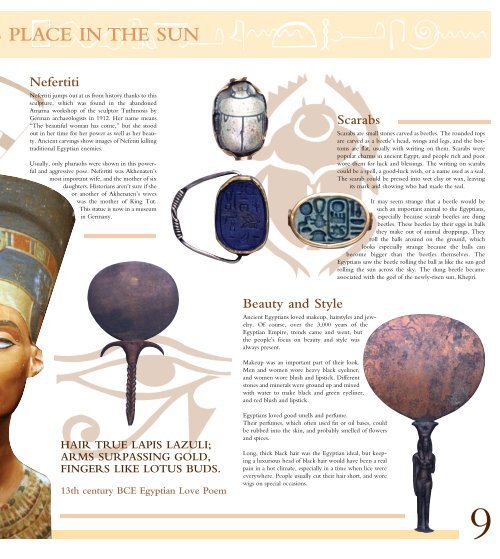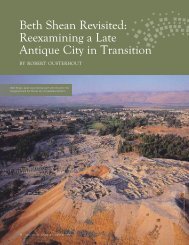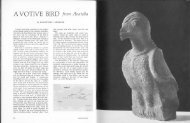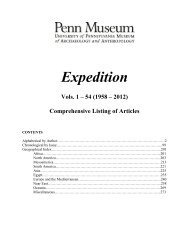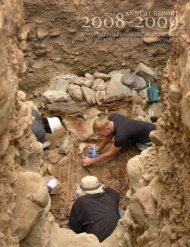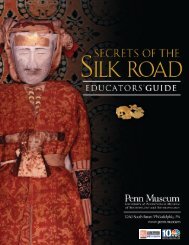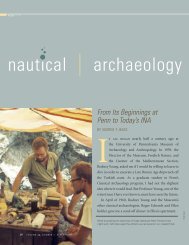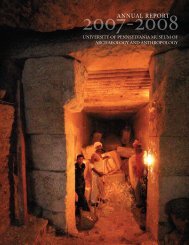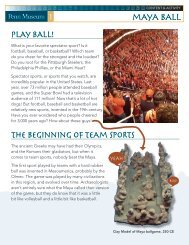ancient egypt's - University of Pennsylvania Museum of Archaeology ...
ancient egypt's - University of Pennsylvania Museum of Archaeology ...
ancient egypt's - University of Pennsylvania Museum of Archaeology ...
You also want an ePaper? Increase the reach of your titles
YUMPU automatically turns print PDFs into web optimized ePapers that Google loves.
PLACE IN THE SUN<br />
Nefertiti<br />
Nefertiti jumps out at us from history thanks to this<br />
sculpture, which was found in the abandoned<br />
Amarna workshop <strong>of</strong> the sculptor Tuthmosis by<br />
German archaeologists in 1912. Her name means<br />
“The beautiful woman has come,” but she stood<br />
out in her time for her power as well as her beauty.<br />
Ancient carvings show images <strong>of</strong> Nefetiti killing<br />
traditional Egyptian enemies.<br />
Usually, only pharaohs were shown in this powerful<br />
and aggressive pose. Nefertiti was Akhenaten’s<br />
most important wife, and the mother <strong>of</strong> six<br />
daughters. Historians aren’t sure if she<br />
or another <strong>of</strong> Akhenaten’s wives<br />
was the mother <strong>of</strong> King Tut.<br />
This statue is now in a museum<br />
in Germany.<br />
HAIR TRUE LAPIS LAZULI;<br />
ARMS SURPASSING GOLD,<br />
FINGERS LIKE LOTUS BUDS.<br />
13th century BCE Egyptian Love Poem<br />
Beauty and Style<br />
Scarabs<br />
Ancient Egyptians loved makeup, hairstyles and jewelry.<br />
Of course, over the 3,000 years <strong>of</strong> the<br />
Egyptian Empire, trends came and went, but<br />
the people’s focus on beauty and style was<br />
always present.<br />
Makeup was an important part <strong>of</strong> their look.<br />
Men and women wore heavy black eyeliner,<br />
and women wore blush and lipstick. Different<br />
stones and minerals were ground up and mixed<br />
with water to make black and green eyeliner,<br />
and red blush and lipstick.<br />
Egyptians loved good smells and perfume.<br />
Their perfumes, which <strong>of</strong>ten used fat or oil bases, could<br />
be rubbed into the skin, and probably smelled <strong>of</strong> flowers<br />
and spices.<br />
Long, thick black hair was the Egyptian ideal, but keeping<br />
a luxurious head <strong>of</strong> black hair would have been a real<br />
pain in a hot climate, especially in a time when lice were<br />
everywhere. People usually cut their hair short, and wore<br />
wigs on special occasions.<br />
Scarabs are small stones carved as beetles. The rounded tops<br />
are carved as a beetle’s head, wings and legs, and the bottoms<br />
are flat, usually with writing on them. Scarabs were<br />
popular charms in <strong>ancient</strong> Egypt, and people rich and poor<br />
wore them for luck and blessings. The writing on scarabs<br />
could be a spell, a good-luck wish, or a name used as a seal.<br />
The scarab could be pressed into wet clay or wax, leaving<br />
its mark and showing who had made the seal.<br />
It may seem strange that a beetle would be<br />
such an important animal to the Egyptians,<br />
especially because scarab beetles are dung<br />
beetles. These beetles lay their eggs in balls<br />
they make out <strong>of</strong> animal droppings. They<br />
roll the balls around on the ground, which<br />
looks especially strange because the balls can<br />
become bigger than the beetles themselves. The<br />
Egyptians saw the beetle rolling the ball as like the sun god<br />
rolling the sun across the sky. The dung beetle became<br />
associated with the god <strong>of</strong> the newly-risen sun, Khepri.<br />
9


